 |
||
|
||
| ||
 Today the most powerful video cards (the ATI R200 is, however, coming very soon, and NVIDIA GeForce3 may compete against it only with the help of reduced prices) have an entirely identical design based on the NVIDIA's one among all Asian card makers who bother about only different PCB color and different logotypes or stickers. That is why today you can find a lot of identical video cards selling in different boxes with different software sets. I have already written about several such cards (e.g. from InnoVision, ELSA, MSI). Below I will give you a list of all reviews of GeForce3 based cards. Only few companies (ASUS, SUMA) have developed products different from the reference one. Of course, the reference based card will be highly reliable and stable. But it doesn't mean that all standards of the reference design will be complied, and 2D quality may be worse. That is why the dull replication of the reference design is positive. But by the example of AGP-V8200 card ASUS has proved that a well thought-out video card may feature the same stability and reliability as the reference card does. But the smaller companies which are less experienced do not make attempts to create something of their own. Well, that's a rational way. SUMA, however, has also implemented its Platinum GeForce3 based on the reference card, which has only a bit altered shape of the PCB. But soon both SUMA and Leadtek are going to release something new (SUMA seems to be in the course of development yet, and Leadtek has already announced Leadtek WinFast GeForce3 TDH equipped with hardware card status monitoring). Another factor that joins all these cards is a high price. Today the GeForce3 is available at $300. With such money you can afford a modern mainboard and a powerful processor! But when more and more new cards appear on the market with the gradual reduction of the price for the GF3, a user hesitates whether to buy a ASUS AGP-V8200 or it is better to take Inno3D Tornado GeForce3 which is much cheaper and offers all the same functions. Well, the answers for all these questions can be found in all our reviews of such cards. The whole theoretical base connected with this GPU is concentrated in the following articles (here you can also learn the peculiarities of definite cards and find out how they operate in the latest benchmark tests):
As you can see, the review of the Gainward was the last where we examined the GeForce3. But when new software was launched I found out that there is still something to discuss. Today we will talk about the anisotropic filtering of not only Level2 but also Level8 appeared in the latest version of drivers (Direct3). The today's card to study is Palit Daytona GeForce3. Palit with its Daytona series is known yet since a Riva TNT2. But cards from this company often get into the 'Noname products' sector. The general trend to install slow memory on relatively cheap cards has touched this company as well. That is why GeForce2 MX cards from Palit can often have decreased memory frequencies. But expensive GeForce2 Pro cards are equipped
with high-quality fast Today, when GF3 based cards are produced not only
by brand-name manufacturers but also by minor firms, when prices
are falling down, the product can't be consider a High-End
article. But on the other hand, it is very advantageous for users
who need Let's see whether such companies maintain the quality and reliability of operation. CardThe Palit Daytona GeForce3 has AGP x2/x4 interface, 64 MBytes DDR SDRAM memory located in 8 chips on the right side of the PCB.. 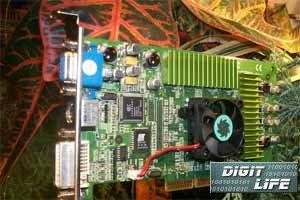 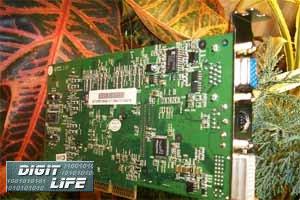 EliteMT produces memory chips with 3.8 ns access time, which corresponds to 260 (520) MHz. Like all other GPU GeForce3 cards, this one works at 200/230 (460) MHz. The memory modules are covered with standard heatsinks that is why I decided not to tear off the latter ones to look at the memory. 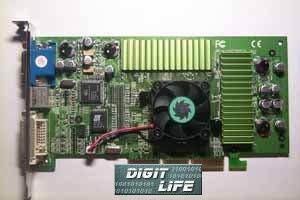 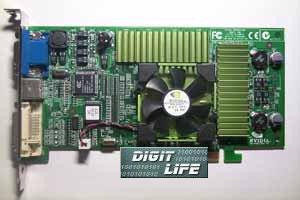 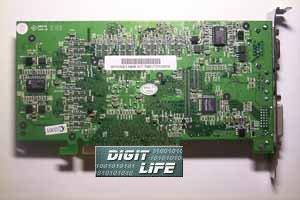 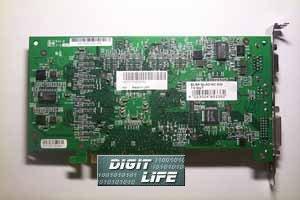 Upper you can see the Palit Daytona GeForce3, and lower there is a reference NVIDIA GeForce3 card. On the animated GIF below you can see the same part of the card (the Palit Daytona GeForce3 is light green, while the reference card is dark green): 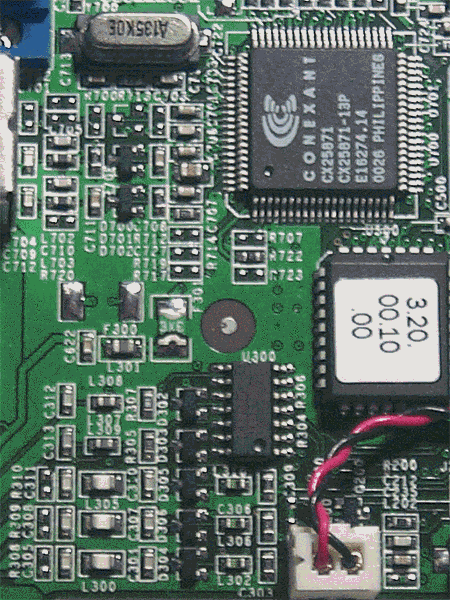 The cooler is, however, different, from the reference card's one. But this one is rather weak for the GeForce3. In a tight case with weak air circulation the overheat make happen very soon. Fortunately, the cooler is attached with clips and you can easily replace it with a more powerful one. The card is equipped with a DVI interface for digital
monitors and with TV-out with an S-Video connector
(so, if you have a TV set 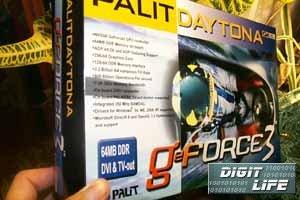 The card ships in a Retail package which includes only 1 CD for many cards :( OverclockingWith the additional cooling provided the Palit Daytona GeForce3 can reach 240/265 (530) MHz. It seems that such low results in overclocking are caused by bad heat transfer between the heatsinks and the memory. Note:
Installation and driversTest system configurations:
For testing we used drivers from NVIDIA of 12.90 version, VSync was off, S3TC technology was activated. For comparative analyses the results of the following cards are used:
The card is supplied together with the NVIDIA v.12.40 drivers. Test resultsAs the experience shows, cards of this class usually have excellent 2D quality. But you should take into account that 2D quality greatly depends on a definite sample. However, all expensive video cards (GeForce2 Pro and higher) based on the reference design from NVIDIA have much less defects in 2D quality than Low-end cards. The Palit Daytona GeForce3 has very good 2D quality. Even in 1600X1200 at 85 Hz you won't feel discomfort, and exactly this resolution and this frequency is a starting point of worsening of quality as the resolution grows. Note, though, that a comfortable work can be achieved with a large high-quality monitor. Sometimes a soapy image may be caused not by a video card but by a defective monitor. For estimation of 3D quality we used the following programs:
Quake3 Arenademo002, standard modesThe tests were carried out in two modes: Fast (16-bit color) and High Quality (32-bit color). 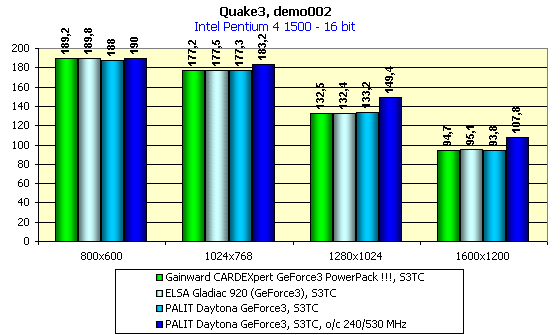  This test shows that this card doesn't differ in the performance from other video cards of this family. For more detailed information on the performance of GeForce3 cards on different platforms refer to our 3Digest. 3DMark2001 ProWith the 3DMark2001 we will again look at the performance of anisotropic filtering in Direct3D. Starting from v12.90 of drivers it is possible to force not only Level 2 but also Level 8. Unfortunately, these possibilities are still locked in drivers, that is why the anisotropy can be activated only with Riva Tuner (of Alexei Nikolaychuk AKA Unwinder unwinder@medicom-mtd.com) or by direct editing of the Registry. Operation of different levels of anisotropy was already studied by the example of OpenGL applications. On the one hand, the picture is beautiful; on the other hand, the performance drop is not little. We have already discussed what number of texture samples (8, 16 or 32) corresponds to one or another Level, but such regularity is conditional and indicates only the maximum possible sampling at the definite level of anisotropy. In practice the anisotropic filtering may use different number of samples depending on a scene, angle of inclination etc. Let's see what is the cost for activation of Level 8. Game1, Low details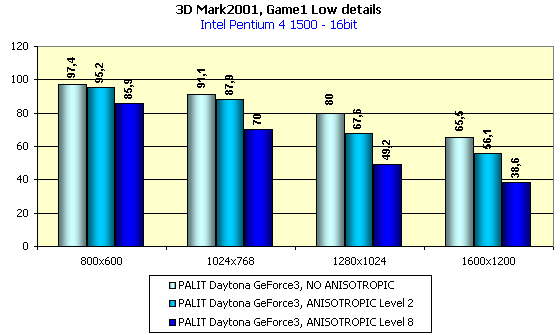 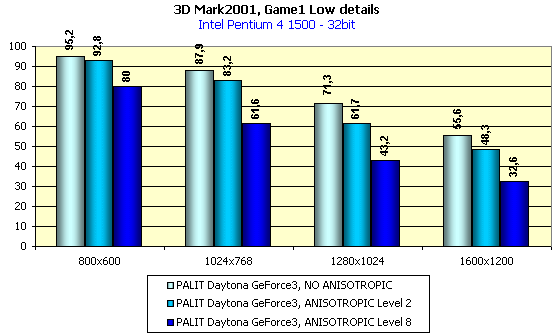 Game2, Low details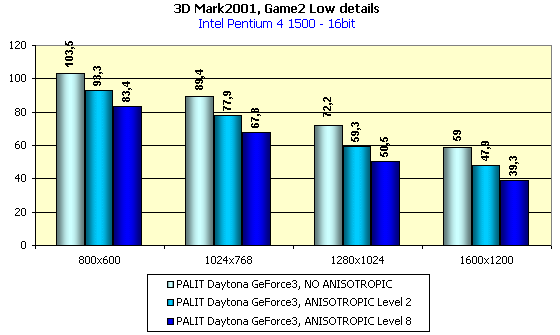 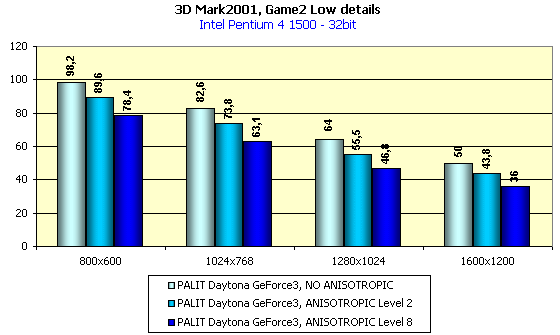 Game3, Low details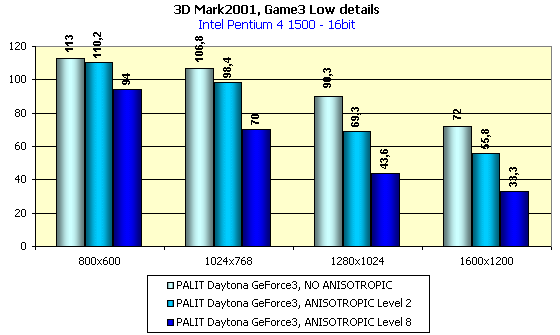  Well, the cost is high. The speed drop, as you can see, is different on different Game-tests with the color depth being the same. It means that the adaptive anisotropy is enabled, i.e. the number of samples in each Game-test is not the same. But now let's look at the quality obtained with the anisotropy. The Max Payne game (based on the same engine as
the 3DMark2001 is) will help us estimate the quality. Well, the effect is super! So, if you don't need hundreds of FPS for your game, then it is better to enable this feature. Now comes another game - Microsoft Train Simulator. Here the anisotropy must be enabled! Look at the rails: the bilinear filtering spoils them much, while the trilinear one is unsupported. That is why this function is just obligatory in some games despite a considerable performance drop. ConclusionThe Palit Daytona GeForce3 has every chance for success because its price is not high, and because it follows the reference design which means highly reliable operation. As for the 2D quality, I can't guarantee that all cards will have
it excellent,
Well, the card is worth dealing with, but you should remember that the cooler should be replaced with a more powerful one, and that among the accessories there is only one CD with drivers. At such sum of money one can find a GeForce3 card with a normal, interesting software set. The complete characteristics of video cards of this and other classes can be find in our 3Digest. Highs:
Lows:
Write a comment below. No registration needed!
|
Platform · Video · Multimedia · Mobile · Other || About us & Privacy policy · Twitter · Facebook Copyright © Byrds Research & Publishing, Ltd., 1997–2011. All rights reserved. |